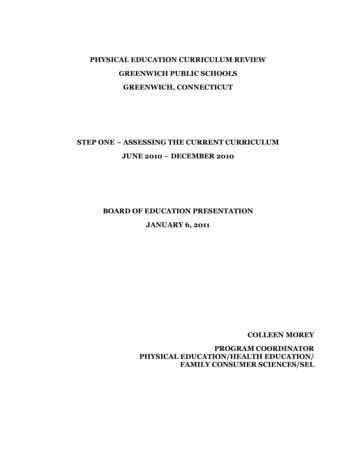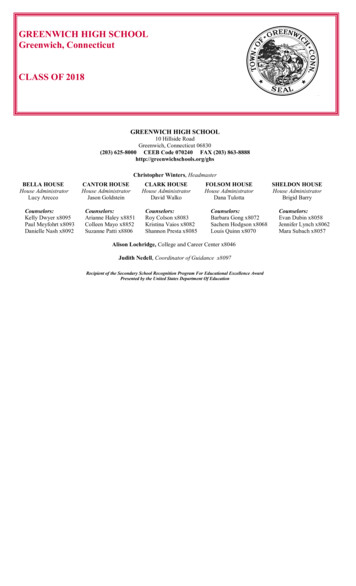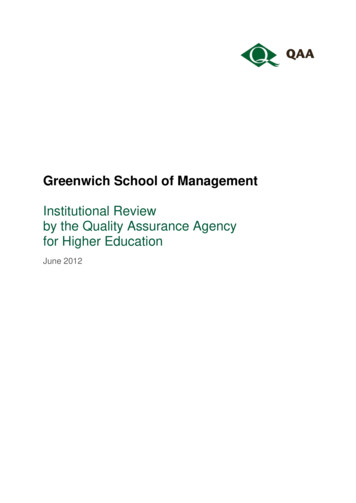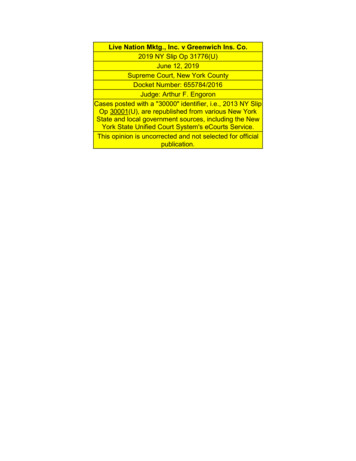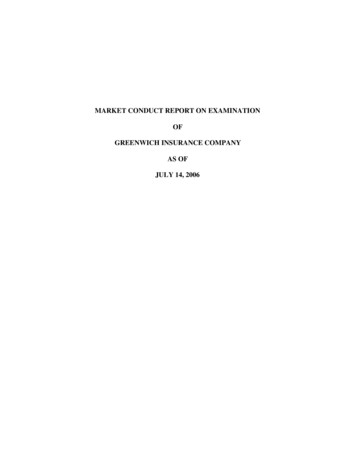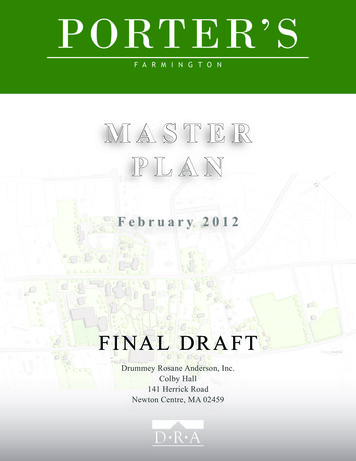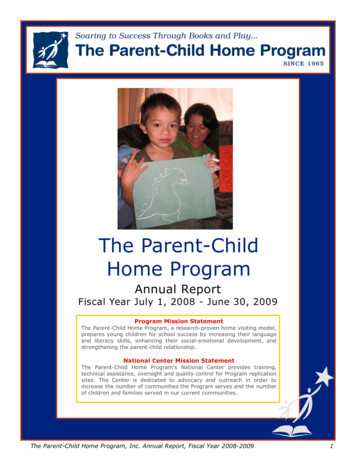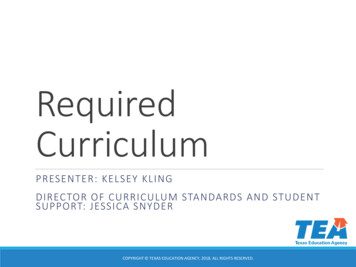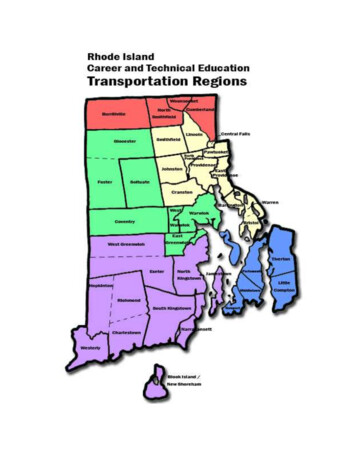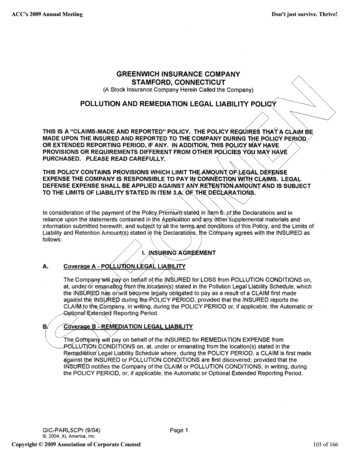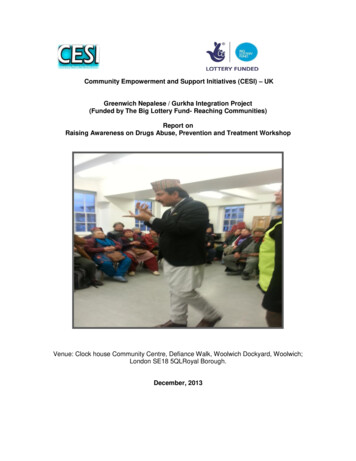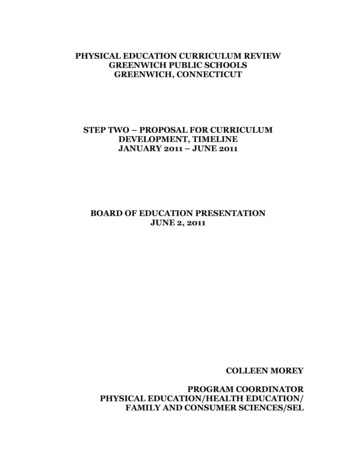
Transcription
PHYSICAL EDUCATION CURRICULUM REVIEWGREENWICH PUBLIC SCHOOLSGREENWICH, CONNECTICUTSTEP TWO – PROPOSAL FOR CURRICULUMDEVELOPMENT, TIMELINEJANUARY 2011 – JUNE 2011BOARD OF EDUCATION PRESENTATIONJUNE 2, 2011COLLEEN MOREYPROGRAM COORDINATORPHYSICAL EDUCATION/HEALTH EDUCATION/FAMILY AND CONSUMER SCIENCES/SEL
PHYSICAL EDUCATION CURRICULUM REVIEW2010-2012History – Step One Curriculum Review Summarypage 1Curricular Proposals – Step Twopage 3Essential Questionpage 3Elementary Programpage 4Middle Schoolpage 6High Schoolpage 9Professional Learningpage 14Appendix A - Timelinepage 15Appendix B – Format for Curriculum Objectivespage 16
HISTORYStep One – Assessing the Current Curriculum - 01/04/2011In Step One of the Physical Education Curriculum Review, the BOE waspresented with a summary from the 2001 Curriculum Review that citedrecommendations for improvement. Included in the January 4th presentationwere the steps taken to address those recommendations between 2001 and 2010.Additionally, the BOE was provided with a detailed report specific to both thecelebrations and deficiencies in the PE Curriculum as aligned with best practicesinherent in Physical Education and 21st Century programming. The GPS PEcurriculum was aligned in four best practice areas –learning environmentcurriculumassessment andprofessionalismThe following gaps were cited:Learning Environment –o Facilities need to be updated and expandedo Technology needs to be updated and expandedCurriculum –o Technology infusion needs to be consistento Adventure programming needs to be expanded and consistento Scheduling obstacles need to be addressed – particularly atsecondary levelo Aquatics programming needs to be expanded vertically andhorizontallyo Trans-disciplinary instruction needs to be expandedo Budget needed to support enhanced programmingAssessment –o Enhanced technology neededo State of art equipment for student assessmentProfessionalism –o Professional development opportunities needed to supportaforementioned programming deficiencieso Certification courses for program expansiono Explore volunteerism for enhanced program deliveryAs such, the following summative recommendations and next steps wereidentified as needed to update the curriculum and address areas of deficiency:o Curriculum content to be expanded to include: a balance of adventure/exploratory/team development,fitness-based curriculum,1
enhanced trans-disciplinary programming,capstone/assured experiences,21st century programming (Vision of the Graduate), andtechnology.o Focus on quality of instruction (Professional Learning) –particularly at the secondary level, and to address discrepancies infitness achievement.o Address facility and equipment issues, particularly technologyo Provide a proposed framework for a middle school thatincorporates components of best practices as identified in schools –DRG A and DRG B.2
CURRICULAR PROPOSALSStep Two – Objectives, Timeline and Action PlanMembers of the Physical Education Department curriculum review team met forone full day and two half-day work sessions to prioritize areas of deficiency in thePhysical Education Curriculum and to develop an action plan and timeline foraddressing the gaps and program needs as detailed in Step One. The content anddelivery of the Elementary Physical Education Curriculum will continue with theexisting (BOE approved) instructional objectives, which are developmentallyappropriate, state and nationally aligned and standards based. Capstone projectssimilar to the 5th Grade Orienteering Meet were developed for incremental gradelevels – Second, Eighth, and Tenth/Eleventh. A curriculum framework wasdeveloped for secondary levels (grades 7 – 11), that focuses on trans-disciplinaryunits, mini-courses and electives opportunities, improved and consistenttechnology infusion, peer mentoring, family and community connections, youthwellness and 21st century instruction. Proposals were identified for programmingbeyond the school day (as appropriate) as well as for remedial/supplementalprogramming within the school day. Following approval from the BOE, acurriculum writing team will convene to detail the grade level revisions specific toinstructional objectives within each content standard. Student assessments willbe developed concurrently.ESSENTIAL QUESTION:How do the activities in which I engage, the information I learn, therelationships I experience and the decisions I make impact mypersonal wellness and participation in lifetime sport, recreation, andactivity pursuits?o Motor Skills and Movement Patternso Application of Concepts and Strategies and Recognition ofthe Benefits of Physical Activityo Physical Fitness and Engagement in Physical Activityo Social Responsibility, Team Building, and Working withOthers through Physical Activity3
Elementary Physical EducationK – 5 and 6th Grade Overview ProposalCORE CURRICULUM - The Elementary Program will continue to emphasize adevelopmental instructional program for skill mechanics and techniqueacquisition for engagement in health-enhancing physical activities. Articulatedboth vertically and horizontally, the curriculum provides instruction in a rigorousinventory of fitness-based and sport-transferrable skills. Students will master thebasics of gross and fine motor tasks through a sequential delivery model ofinstruction. Balance, coordination, and fitness will provide the foundation formovement from basic movement patterns to more complex sequences andmature applications for sport, activity, movement and recreational engagement.Instruction will continue to provide an aggressive inventory of skill andknowledge learning opportunities for student application and transfer into a widerange of lifetime sport and activity pursuits, with an emphasis on 21st Centuryopportunities. The 5th and 6th grade program will provide opportunities forengagement in a wide range of sports and activities which demand mature skillcombinations and performance as well as application of game and sportstrategies. A strong fitness foundation will provide students with theopportunities for developing their own fitness program specific to preferred sportand leisure activities and pursuits, and the skills and technology through which tomonitor and self assess personalized programs. Beginning in the 6th grade,students will maintain a fitness portfolio that will track the students throughoutthe remainder of their GPS PE experience. This will include components offitness, health indicators, and sport and activity course completion documentsand certifications.ASSURED EXPERIENCES/TRANSDISCIPLINARY INSTRUCTION willbe showcased in the second, fourth, and fifth grades. These will nurture a blendof physical education program objectives and a variety of trans-disciplinaryinstructional objectives inherent in each grade level. Students will engage inthese experiences with students from their same cluster – CMS, EMS, WMS andtravel to an off-site location within the community.Second graders will celebrate their ancestry through a dance/games ½ dayprogram at the Boys and Girls Club. Tied to their Social Studies unit on ancestry,students will culminate their learning with a half day of participation ininternational games and dances that they will learn through their PE classes andshowcase for their peers at their ANCESTRY DAY CELEBRATION. This will bethe first year of this program and objectives will be written specific to thelearning. A budget will also be developed and proposed through the PhysicalEducation program.Fourth grade students will visit the YMCA for ½ day followingparticipation during the fall in the annual State of Connecticut FitnessAssessment. Schools will be scheduled to visit the YMCA for ½ day where theywill team with the town to participate in the PRESIDENTIAL FITNESSCHALLENGE to qualify the Town of Greenwich for the “most-fit” community inthe nation. This experience is exclusively fitness-based and includes pull-ups,4
pacer test, sit-ups, sit and reach, shuttle run, and flexed arm hang. Followingtabulation of each student’s score, a six-week fitness program is provided forstudent fitness maintenance and improvement. This will be the first year ofimplementation of this program after piloting it during the 2010-2011 schoolyear.Fifth grade students will continue to attend the ORIENTEERING MEETheld at Camp Seton. This will mark the 6th year of this district-wide program.This collaborative program uses the modalities of orienteering and adventure toengage students in a trans-disciplinary day of challenge, team building, problemsolving and nature-based activities. The Greenwich Boy Scouts and GPS PEteachers work together to create a day where students celebrate learning in awide range of disciplines while connecting with students with whom they willattend middle school in the 6th grade.ASSESSMENT - The current Physical Education Curriculum objectives will berevised to include enhanced technology specific to student learning, engagementand assessment. Use of IPADS, Flip Video Cameras, Heart Rate Monitors, andInstructional DVDs will provide immediate feedback to students for formativeassessments. It is recommended that an IPAD and FLIP VIDEO and IBOOK arepurchased and housed at each elementary school gymnasium for use ininstruction and assessment, as well as classroom sets of Heart Rate Monitors,Pedometers, and Heart Rate Stands. Fitness Portfolio will track studentsthroughout grades 6 – 12. Purchase of technology will take place through aphase-in plan in the Physical Education program budget.SEL - A focus on cooperation verses competition, team-building and personalresponsibility, and personal fitness development, improvement and maintenancewill be cultivated throughout the curriculum delivery. Use of adventure-basedinstructional strategies and programming will be deployed across the districtusing The Vision of the Graduate as the framework. Schools deficient inadventure equipment will be slated for purchase and installation through acyclical infusion plan as recommended by the Program Coordinator and deemedappropriate by the BOE and budget feasibility.FITNESS - A fitness-based Response to Intervention, (RtI) will be provided forall elementary students who fail to achieve age-appropriate fitness as evidencedthrough state standardized and locally designed fitness indicators. A .1 billet thatis already budgeted and assigned will be re-designated for each elementaryschool to provide the time and staffing needed to address this area of deficiency.Before-school programs will be explored whereby PE staff will providesupervision for students prior to the start of the school day (released from sitebased duties) in areas of fitness and remedial/support. Additionally, a beforeschool fitness pilot program will be proposed for students in the HamiltonAvenue School utilizing a collaborative approach with the Boys and Girls Clubstaff and facility. There are no anticipated budgetary implications for thedevelopment and delivery of this program for the BOE.5
MIDDLE SCHOOL - 7th and 8th Grades – Overview ProposalCORE CURRICULUM - The proposed Middle School Physical EducationProgram calls for the greatest deviation from current programming protocol,which traditionally has been framed by team and individual sport pursuits. Thefitness-based program will provide students with opportunities for participationin “mini-courses” which infuse technology into adventure, fitness, and sports –individual, team and lifetime. Having completed the k-6 program, students willbe exposed to ten different sport and activity units through which they will applythe skills and knowledge previously learned. As much as is possible, students willbe scheduled into high cardio classes prior to their more challenging academiccourses so that achievement may be enhanced. Additionally, scheduling whichrecognizes the students’ individual needs for activity will be considered – stressmanagement/relaxation, boot camp, weight management, social responsibility,fitness and conditioning, sports exposure. Any scheduling changes will be in linewith overall middle school exploration of scheduling options and will beincorporated as determined feasible by middle school administration.7th and 8th Grade Components:Ten instructional units (3 weeks each)Exploration of PE scheduling during the school day prior to challengingacademic classes – individual students will be identified for this optionExplore combining 7th/8th grades for instructionZero Block (before school) PE class (for students w/individual needs –fitness) will be explored – consultations with the teachers’ union regardingflexible time has begunSample Units:o Spinning (7th/8th)o Fitness - Boot Camp, aerobics, conditioning, weight management,high cardioo In-line skatingo Climbing/adventure – low and high elements – indoor and outdoor– locally accessedo Kickboxingo Wellness/Fitness Learning Center – trans-disciplinary instructiono Snow shoeing (weather permitting), winter gameso Lifetime recreation – bocce, golf, Disc Golf, croquet, hiking, racquetsports, diamond sports, danceo Team and individual traditional sports units – indoor soccer,striker, touch rugby, touch/flag football, handball, volleyball,basketball, pass ball, track and fieldo Community facilities accessed for selected units/experienceso Technology based fitness - Dance Dance Revolution, Virtual cyclingo Adventure-based SEL component – orienteering, high and lowelements, compass and maps, adventure racingo Fitness-based wellness – nutrition, body systems, body composition6
Assessmento Assessment through activityo Tri-fit health fitness profile assessment that tracks students throughHS - portfolio of programmingo Rigorous Peer/technology-based assessmentso Completion certificates for alternative sports – (ie. hiking, etc. vs.report card grade)Lunch recess intramural/fitness program (RtI)o Students scheduled into or registered for programo Students submit team registero PE teachers utilized for remedial or intramural programming asopposed to site-based duties if schedule permits as per middleschool scheduling initiativeo Staff available for tournament supervision as opposed to lunchdutieso Fitness center staffed for student accessASSURED EXPERIENCE – Eighth grade students will engage in a ½ day(possibly full day) off-site fitness-based assured FITNESS PRO-MOTIONprogram in which they will experience a variety of electives courses including, butnot limited to, kick boxing, water aerobics, rock climbing, Pilates, hip hop classes,Zumba, skating – on line and/or ice, spinning, and martial arts. The emphasis ison cardio conditioning and use of heart rate telemetry will be incorporated aswell as personalized data collection specific to cardio fitness. A partnership withthe local YMCA will be explored for the venue and collaboration with the YMCAteam of professional fitness trainers.ASSESSMENT - The current Physical Education Curriculum objectives will berevised to include enhanced technology specific to student learning, engagementand assessment. Use of IPADS, Flip Video Cameras, Heart Rate Monitors, andInstructional DVDs will provide immediate feedback to students for formativeassessments. It is recommended that an IPAD and FLIP VIDEO and IBOOK arepurchased and housed at each elementary school gymnasium for use ininstruction and assessment, as well as classroom sets of Heart Rate Monitors,Pedometers, and Heart Rate Stands. Fitness Portfolio will track studentsthroughout grades 6 – 12.SEL - A focus on cooperation verses competition, team-building and personalresponsibility, and personal fitness development, improvement and maintenancewill be cultivated throughout the curriculum delivery. Use of adventure-basedinstructional strategies and programming will be deployed across the districtusing The Vision of the Graduate as the framework. Schools deficient inadventure equipment will be slated for purchase and installation through acyclical infusion plan as recommended by the Program Coordinator and deemedappropriate by the BOE and budget feasibility.7
FITNESS – The Middle School PE program will be a fitness-based program withan intense cardio component. Starting in the 6th grade, students will monitortheir personal health-related fitness data, which will be tracked throughout theirremaining GPS PE program experience. A goal of personal fitness improvementwill be in place for all students and this will be supported through programmingopportunities to help students meet their personal objectives for supporting thisgoal. The curriculum review committee recommends the purchase of a TRI-FITSYSTEM for each middle school. This device will enable teachers to administer awide range of health-related fitness assessments and provide personalizedreports for students on fitness, healthy living behaviors, nutrition, andrecommendations for improvement and maintenance.It is recommended that a Zero block is scheduled before the instructional day ateach middle school when students can come to access the Fitness Center(s)and/or utilize other activity and fitness equipment and/or opportunities prior tothe school day. Additionally, a mid-day (lunch block) intramural/fitness block isrecommended for students who may want to engage in activity or improve theirfitness through sport or activity pursuits. Development of SPARK programming(SPARK programming utilizes various cardio-based activities, which enhance thesignaling and production of neurotransmitters in the brain, thus improving thebrain’s performance. SPARK programming typically provides students withengagement in these specific activities at incremental times during the day.) forstudents who need the additional activity throughout the day is recommended.8
HIGH SCHOOL – Overview ProposalStudents in the High School PE program will have opportunities to engage in acore program, which offers a range of sports and activities within distinctcategories. Given that the high school student’s program is divided into quarters,two of which are wellness in grades nine and ten, there are six quarters duringwhich the students may engage in physical activity pursuits. The categoriesprovide opportunity for engagement from four different categories of offerings.As such, students would be required to engage once in each of aquatics,adventure, fitness, and team sports; and twice in activities from individual sports,from which they would select two categories of personal interest.Grades 9 & 10Aquatics Program (all delivered in GHS pool):Basic Instruction required with the opportunity to “test out” (whichincludes a water safety requirement)Water PoloUnderwater hockeyKayaking/paddle boarding/canoeingScuba/snorkelingWater aerobics and Aquatic ZumbaSwim fitness and conditioningAdventure Program:Low elements initiativesTeam buildingLeadershipTrustCritical thinking/problem solvingBelay teamHigh elements introductionOrienteeringFitness Program:Orientation - Beginner to AdvancedFitness EquipmentFitness TechnologyComponents of fitnessSelf designed fitness programIndividual Sports Program (select 2): Racquet Sports Pickleball Table tennis9
Badminton Tennis Eclipse ball Volleyball – TennisLifetime/Leisure Bocce Rollerblading Golf Cross country skiing Snowshoeing Disc GolfCycling Spin center Virtual bikesWalking/Strides Par Course Hiking Power Walking Treadmill/Elliptical JoggingRhythms and Relaxation Kickboxing Zumba Dances Hip Hop Yoga/Pilates Stress management Tae Kwon DoTeam Sports Program: Rugby - touch Ultimate Frisbee Soccer Handball teams Volleyball Basketball Flag Football Pass ball11th and 12th Grade Electiveso Zero Block Morning PE – 6:30 to 7:15 a.m. (as per GEAconsultation and flexible scheduling accommodations) Fitness Center10
Pool programmingGroup Exercise Sessions - Take course prior tocertification class – during certification classes - teachunderclass courses as assistantZumbaKickboxingPilatesStep aerobicsSpin BikesBoot camp fitnessAdventure RacingAdventure low and high elementsOrienteering with Adventure/Geocache/Compasses and MapsStress management/dance/relaxation Yoga Jazz Hip hop SocialGolfRollerbladingPower walkingIn-Line SkatingTeam sports offeringsFitness centerRacket sports (net sports) – inclusive of allAquaticsAlternative Lifetime/Recreational Sports – bocce, ultimate Frisbee,disc golfGroup Exercise Sessions - Take course prior to certification class –during certification classes - teach underclass courses as assistantZumbaKickboxingPilatesStep aerobicsSpin BikesBoot camp fitnessAcademic trans-disciplinary/physical activity course - lecture/lab –strong science-baseCertification Courses Emergency Medical Technician Athletic Training – currently in place, BOE approved Lifeguard Training - currently in place, BOE approved Personal Training - currently in place, BOE approved Group Exercise Instructor - Use students for 9th/10th gradeor in community oooooooooooooooo11
12th Grade Only:o Earned privilege - one quarter off-site (individual scheduledpermitting so as to avoid interruption of course schedules)o Extreme sports – kayaking and canoeing – in GHS pool, cycling,winter sportso Internships/Career PE – senior citizens/companies/hospitals (i.e.work with seniors, Head start, daycare, toddlers, preschool,rotations) This would be explored in line with current studentinternship program such that students might participate in PE andPE career related internship placements.ASSURED EXPERIENCE – High School students (10th or 11th grade) willparticipate in a one day off site program through which they will apply learningand experiences from instruction in fitness, adventure, SEL, and a variety ofsports to engage in an ADVENTURE RACING initiative. Using off-site facilities(possibly Alley Pond or Todd’s Point or Camp Simmons), students will work witha team of peers to answer trans-disciplinary questions, and solve problems andchallenges posed to them in an adventure-based day of critical thinking and teambuilding, steeped in fitness and physical activity.ASSESSMENT - The current Physical Education Curriculum objectives will berevised to include enhanced technology specific to student learning, engagementand assessment. Use of IPADS, Flip Video Cameras, Heart Rate Monitors, andInstructional DVDs will provide immediate feedback to students for formativeassessments. It is recommended that an IPAD and FLIP VIDEO and IBOOK arepurchased and housed at each elementary school gymnasium for use ininstruction and assessment, as well as classroom sets of Heart Rate Monitors,Pedometers, and Heart Rate Stands. Fitness Portfolio will track studentsthroughout grades 6 – 12.SEL - A focus on cooperation verses competition, team-building and personalresponsibility, and personal fitness development, improvement and maintenancewill be cultivated throughout the curriculum delivery. Use of adventure-basedinstructional strategies and programming will be deployed across the districtusing The Vision of the Graduate as the framework. Schools deficient inadventure equipment will be slated for purchase and installation through acyclical infusion plan as recommended by the Program Coordinator and deemedappropriate by the BOE and budget feasibility.FITNESS – The GHS program will continue to be grounded in a strong fitnessbase with cardio fitness maintaining a desired focus for all students. Studentswill be oriented to the GHS Fitness Center through the fitness course in 9th and10th grades, and additionally, each of all PE courses will provide opportunitiesfor, and expect, high levels of fitness achievement for all students. Using the TRIFIT System, students will be monitored on personal fitness levels from which12
they will identify goals and benchmarks, and design programming, to achieve andmaintain optimal personal fitness. A Zero Block enrichment program will beoffered for students to work on fitness – through participation in the FitnessCenter – as well as through mini-courses (Zumba, Kickboxing, Boot Camp, StepAerobics) through which they can attain and maintain personal fitness. Staffingfor the Fitness Center is needed throughout the school day, which will provideopportunities for student and staff access during open blocks. Mid-dayintramurals will be revisited as a supplemental component of programming atGHS. Possible drop-in activities ranging from 3 0n 3 basketball to Hip Hopinstruction will be considered.13
PROFESSIONAL LEARNINGA rigorous program of Professional Learning will be provided for all staff, k-12specific to:Instructional Strategies – specific to:TEPL indicators21st Century learningBest practices in PEFitness programmingTechnology –IpadITouchHeart Rate TelemetryTRI-FIT technologyMiscellaneous software specific to programming initiativesAdventure programming – inclusive of:OrienteeringExtreme sports (kayaking, canoeing, climbing),Lifetime activities (snowshoeing, rollerblading)Certification courses –Lifeguard TrainingAthletic TrainingPersonal TrainingGroup Exercise courses –ZumbaPilatesSpin CyclingBoot Camp14
APPENDIX APHASE IN PLAN – TIMELINETASKRevision of curricularobjectives, development ofPE curriculum mapDevelopment of new PEcourse and initiativesobjectivesProfessional LearningprogramsBudget development specificto curriculum revisionsBudget presentation –specific to new courses andinitiativesPERSONS INVOLVEDPhysical Educationcurriculum team,Program CoordinatorPhysical Educationcurriculum team; inputfrom students & parentsk-12 PE staff, ProgramCoordinatorPhysical Educationcurriculum team,Program CoordinatorPhysical Educationcurriculum team,Program CoordinatorTARGET COMPLETIONSpring/Summer/Fall 2011Spring 2012Spring 2012October 2011September 201215
APPENDIX BRecommended Format for Physical Education Content StandardsFor each grade level and elective course, instructional objectives will be identifiedspecific to the four content standards. These areas reflect the National and Stateof Connecticut Physical Education Standards as defined by AAHPERD - TheAmerican Association of Health, Physical Education, Recreation, and Dance, andNASPE - The National Association of Sport and Physical Education. Theseassociations have identified six standards, however in keeping with national bestpractices and for meaningful student assessment purposes, the GPS PEcurriculum review team has clustered them into four standards. Formative andsummative assessments will be administered and data collected and reported forall students specific to each of these content standards. Additionally thesestandards reflect the areas identified for reporting on the student report cards –by content area rubric indicators on the elementary report card and by lettergrades on the secondary report cards.Instructional objectives will be revised and/or developed specific to each contentarea, and specific to each grade level for all courses – articulated vertically andhorizontally - through a curriculum mapping system.Content Standard – MOTOR SKILLSStudents will acquire and demonstrate competency in various motor skills andmovement patterns to engage in a variety of health-enhancing physical activities.Content Standard – CONCEPTS AND STRATEGIES AND BENEFITSOF PHYSICAL ACTIVITYStudents will demonstrate learning of movement concepts, principles, benefits,strategies and tactics as they apply to engagement in health-enhancing physicalactivities.Content Standard – FITNESSStudents will achieve and maintain a health-enhancing level of physical fitness,based on continual assessment, through engagement in a variety of physicalactivities.Content Standard – SOCIAL RESPONSIBILITYStudents will develop and exhibit responsible personal and social behavior andteam-building skills that respect self and others while engaging in physicalactivities.16
In Step One of the Physical Education Curriculum Review, the BOE was presented with a summary from the 2001 Curriculum Review that cited . Zero Block (before school) PE class (for students w/individual needs - fitness) will be explored - consultations with the teachers' union regarding flexible time has begun
